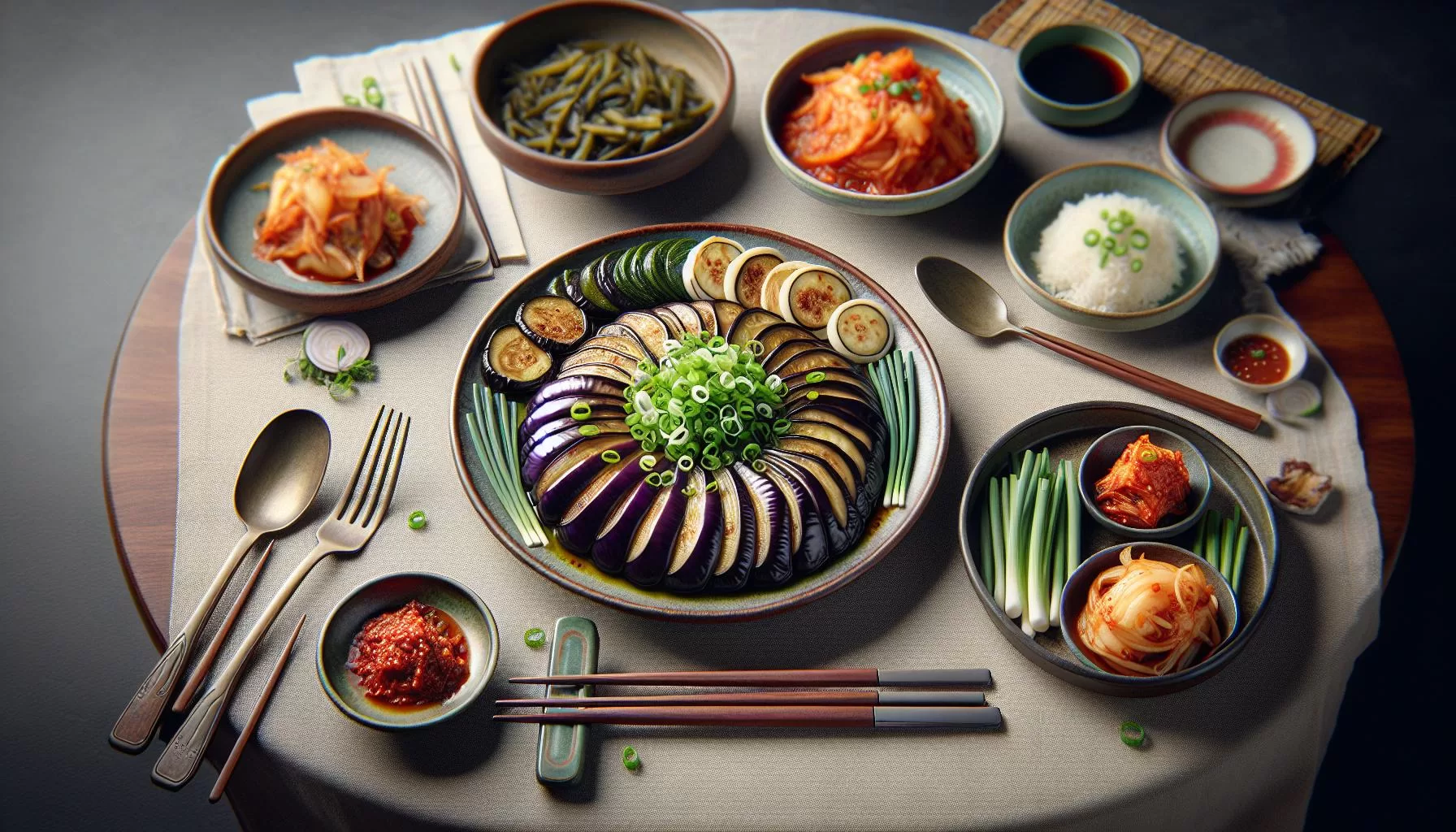Easy Homemade Gaji Namul Recipe – Perfect Korean Steamed Eggplant Side Dish

Choosing the Right Eggplants
It’s time to talk about selecting eggplants for your homemade Gaji Namul. The eggplant, also known as aubergine, is pivotal to the dish. It’s not just any eggplant that makes the cut for this authentic Korean recipe.
The best eggplants for Gaji Namul are usually Asian varieties like Japanese or Chinese eggplants. They’re renowned for their tender, sweet flesh and thin skin. These types provide a slight sweetness, cutting through the savory soy sauce, for balance. Look for eggplants with a vibrant purple skin, firm to touch, and have a uniform color. Avoid those with brown spots or signs of decay.
Don’t worry if these specific types aren’t available near you, the Mediterranean eggplant is a fine substitute. However, be cautious as they’re slightly larger, and the skin can be a bit tougher. But don’t fret! A quick tip: peeling off some of the skin will help you achieve the desired texture.
Sourcing local, fresh, and seasonal produce often gives the best results. When you hold the eggplant, it should feel heavy for its size. That’s a sign of freshness. And always lean towards smaller ones—they are usually less bitter, have thinner skin, and softer seeds.
Providing you a comprehensive view, here’s how these eggplants stack up:
| Type | Taste | Skin | Size | Availability |
|---|---|---|---|---|
| Japanese | Sweet | Thin | Small | Common |
| Chinese | Sweet | Thin | Small | Common |
| Mediterranean | Mild | Tough | Larger | Common |
Lastly, bear in mind that the fresher the eggplant, the less bitter it’s likely to taste. Now that you’re armed with this knowledge, you’ll be better prepared the next time you’re at the market for the perfect Gaji Namul experience. Remember, the excellence of your dish begins with the quality of your ingredients.
Preparing the Eggplants

Now that you’ve got your eggplants, it’s time to dive into the preparation process. Even the best of chefs know good prep work is key to great results!
Begin by washing your eggplants thoroughly to remove any dirt or residue. Cleanliness is next to godliness, as they say. It can’t be stressed enough how important this step is! Next, trim off the ends of your eggplants and cut them into rounds. A thickness of about 1/2-inch should be just about right. This thickness allows for an even absorption of flavor while maintaining the necessary bite.
For those with a more adventurous palate, you might want to experiment by scoring the rounds. This not only enhances the dish’s visual charm but also allows for more flavors to seep into the eggplant.
Having trouble slicing the eggplants? Make sure your knife is up to the task! A dull blade will squish your eggplant rather than slice it. Remember, having the right tools can elevate your cooking experience!
Once your eggplants are cut, soak them in cold water for about 20 minutes. This step works to remove any bitterness. Don’t skip it!
After you’ve finished soaking, you’ll need to cook the eggplants. Steaming is the method of choice. Place the eggplants in a steamer basket, then steam them for about 15-20 minutes. They should be soft when you poke them with a fork, but remember, you don’t want them falling apart. They still need to keep their shape.
The perfect Gaji Namul rests in the balance of tenderness and structure. Keep in mind – whether you’re steaming your first eggplant or your fiftieth, patience is the secret ingredient for successful cooking. Following these steps ensures a flavor-packed Gaji Namul every time. So give yourself a pat on the back. You’re well on your way to a dish deserving of the world’s gastronomic stage.
Making the Seasoning

The flavor journey of your Gaji Namul doesn’t stop at carefully selecting and prepping your eggplants. After ensuring the perfect tenderness, your attention should turn to the vibrant seasoning that makes this dish truly stand out.
Let’s begin. You’ll need:
- 2 tablespoons of soy sauce
- 1 tablespoon of sesame oil
- 1 tablespoon of crushed red pepper flakes
- 1 minced garlic clove
- 2 green onions, finely chopped
- 1 teaspoon of sesame seeds
Simply combine these ingredients in a bowl, stirring until everything is evenly mixed. Be sure to taste as you go, adjusting to suit your personal preference. If your palate craves a unique zest, feel free to add a dash of rice vinegar.
| Ingredient | Quantity |
|---|---|
| Soy Sauce | 2 tbsp |
| Sesame Oil | 1 tbsp |
| Crushed red pepper flakes | 1 tbsp |
| Minced Garlic Clove | 1 |
| Green Onions | 2 |
| Sesame Seeds | 1 tsp |
Introducing these ingredients to your prepared eggplant transforms a humble vegetable into an awe-inspiring dish. The natural umami of soy sauce, the searing heat of red pepper flakes, the aromatic garlic, and crisp, fresh green onions create a symphony of flavors that’s simply irresistible. The light toasting of the sesame seeds adds a nutty touch that complements the earthiness of the eggplant, enhancing the overall complexity of your Gaji Namul.
Don’t worry too much about the caloric intake- this well-rounded seasoning is relatively light, with health benefits to boot. Both soy sauce and sesame oil are known for their rich antioxidants, while garlic offers numerous cardiovascular advantages. On top of that, the green onions pack a punch of vitamins A, C, and K, making this seasoning not just delicious, but nourishing as well.
Your Gaji Namul is starting to take shape, but the process isn’t over. Our next section discusses the final steps and handy serving suggestions to guarantee your homemade Gaji Namul is as authentic and exquisite as it gets. Stay tuned.
Steaming the Eggplants

Let’s shift gear and focus our attention on the star of our dish – the eggplants. Steaming is critical to the overall taste and texture of your Gaji Namul. The beauty of this cooking method is that it preserves the eggplant’s subtle flavors while ensuring it’s not too mushy or too firm.
First, preheat your steamer on high heat. Fill the bottom pot of your steamer with water, making sure it’s not touching the steaming tier. When water comes to a boil, you’re ready for the next step.
Next, prepare your eggplants for steaming. Cut them into long, thin strips, about 1.5 to 2 inches in length. If you’re using large eggplants, halve them lengthwise then slice each half into quarters.
In goes your eggplants into the steaming tier. Spread them out evenly, leaving ample space to allow the steam to circulate effectively. Cover the steamer and allow the eggplants to cook for about 10 minutes.
While you’re waiting, you might be curious about the nutritional value of steamed eggplants.
| Nutrient | Amount per 100g of steamed eggplant |
|---|---|
| Calories | 35 |
| Carbs | 9 grams |
| Protein | 0.8 grams |
| Fat | 0.2 grams |
| Fiber | 2.5 grams |
Following this procedure, your eggplants should offer a delicate flavor and a pleasingly soft (but not mushy) texture. But hey, every stove and steamer is different. So, be sure to check the eggplants after about 7 minutes. The strips should be easy to pierce with a fork yet hold their shape.
If your eggplants still feel firm, continue steaming in increments of 1-2 minutes. Remember, you’re going for ‘tender’, not ‘mushy’. Once done, remove the steamed eggplant carefully and let it cool down before transferring it to a mixing bowl.
Serving and Enjoying Gaji Namul

Next, after you’ve steamed and seasoned your eggplant, you’re ready to serve and enjoy your Gaji Namul. This Korean side dish shines when it’s plated with care. The aesthetics are as vital as the taste in Korean cuisine.
Plating this dish is straightforward. Lay out thin slices of the seasoned eggplant elegantly on a plate. It’s acceptable to overlap the slices slightly for a layered effect. A sprig of fresh parsley or thinly sliced green onions scattered on top can enhance the visual appeal.
Presentation matters, but how you enjoy Gaji Namul is equally significant. This side dish pairs well with a wide range of Korean entrees. Try it with a bowl of warm rice and Kimchi, or eat it with a spoonful of Gochujang (Korean chili paste) for an added kick.
Being versatile, Gaji Namul can be enjoyed either warm or cold. It’s great as a packed lunch option, served with other varieties of Korean side dishes, collectively known as Banchan.
You can also add your creative touch to this classic recipe. Experiment with flavors by adding a sprinkle of toasted sesame seeds, a drizzle of honey, or even sliced almonds.
At this point, you’re not simply preparing a Korean recipe. You’re curating a meal loaded with flavor, nutrition, and culture. Therefore, take a moment to appreciate the aroma, appearance, and taste.
Here’s a quick rundown of the nutritional value per serving of Gaji Namul:
| Nutritional Element | Amount |
|---|---|
| Calories | 70 kcal |
| Carbs | 6.3g |
| Protein | 1.2g |
| Fat | 4.8g |
| Vitamins | A, E, C |
Reading these numbers may seem boring, but understanding them is part of loving the food you make. When you know what you’re eating, you can enjoy your food more. So dig in, savor each bite, and relish the taste of your homemade Gaji Namul.
Conclusion
So, you’ve mastered the art of making Gaji Namul at home. You’ve learned to appreciate the balance of flavors, the importance of presentation, and the versatility of this Korean side dish. It’s more than just eggplant; it’s a culinary experience that pairs perfectly with many Korean entrees. You’ve also discovered how to make it your own, adding personal touches like sesame seeds, honey, or almonds. And let’s not forget about the nutritional value. You’re not only indulging in a delicious dish, but also nourishing your body with essential nutrients. Now, every bite of your homemade Gaji Namul is a testament to your culinary skills and your understanding of Korean cuisine. So go ahead, savor it, share it, and most importantly, enjoy the fruits of your labor. Your homemade Gaji Namul is ready to impress.





